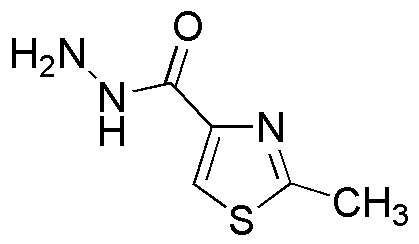2-Methyl-4-thiazolecarboxylic acid hydrazide is widely utilized in research focused on:
- Agricultural Chemistry: This compound is effective as a fungicide, helping to protect crops from various fungal infections, thus enhancing agricultural productivity.
- Pharmaceutical Development: It serves as a key intermediate in the synthesis of bioactive compounds, contributing to the development of new medications with improved efficacy.
- Material Science: The compound is used in the formulation of specialty polymers and coatings, providing enhanced durability and resistance to environmental factors.
- Analytical Chemistry: It acts as a reagent in various analytical methods, aiding in the detection and quantification of specific substances in complex mixtures.
- Biochemistry: This chemical is utilized in biochemical assays, facilitating research into enzyme activity and metabolic pathways, which is crucial for understanding biological processes.
General Information
Properties
Safety and Regulations
Applications
2-Methyl-4-thiazolecarboxylic acid hydrazide is widely utilized in research focused on:
- Agricultural Chemistry: This compound is effective as a fungicide, helping to protect crops from various fungal infections, thus enhancing agricultural productivity.
- Pharmaceutical Development: It serves as a key intermediate in the synthesis of bioactive compounds, contributing to the development of new medications with improved efficacy.
- Material Science: The compound is used in the formulation of specialty polymers and coatings, providing enhanced durability and resistance to environmental factors.
- Analytical Chemistry: It acts as a reagent in various analytical methods, aiding in the detection and quantification of specific substances in complex mixtures.
- Biochemistry: This chemical is utilized in biochemical assays, facilitating research into enzyme activity and metabolic pathways, which is crucial for understanding biological processes.
Documents
Safety Data Sheets (SDS)
The SDS provides comprehensive safety information on handling, storage, and disposal of the product.
Product Specification (PS)
The PS provides a comprehensive breakdown of the product’s properties, including chemical composition, physical state, purity, and storage requirements. It also details acceptable quality ranges and the product's intended applications.
Certificates of Analysis (COA)
Search for Certificates of Analysis (COA) by entering the products Lot Number. Lot and Batch Numbers can be found on a product’s label following the words ‘Lot’ or ‘Batch’.
Numéro de catalogue
Numéro de lot/série
Certificates Of Origin (COO)
This COO confirms the country where the product was manufactured, and also details the materials and components used in it and whether it is derived from natural, synthetic, or other specific sources. This certificate may be required for customs, trade, and regulatory compliance.
Numéro de catalogue
Numéro de lot/série
Safety Data Sheets (SDS)
The SDS provides comprehensive safety information on handling, storage, and disposal of the product.
DownloadProduct Specification (PS)
The PS provides a comprehensive breakdown of the product’s properties, including chemical composition, physical state, purity, and storage requirements. It also details acceptable quality ranges and the product's intended applications.
DownloadCertificates of Analysis (COA)
Search for Certificates of Analysis (COA) by entering the products Lot Number. Lot and Batch Numbers can be found on a product’s label following the words ‘Lot’ or ‘Batch’.
Numéro de catalogue
Numéro de lot/série
Certificates Of Origin (COO)
This COO confirms the country where the product was manufactured, and also details the materials and components used in it and whether it is derived from natural, synthetic, or other specific sources. This certificate may be required for customs, trade, and regulatory compliance.


